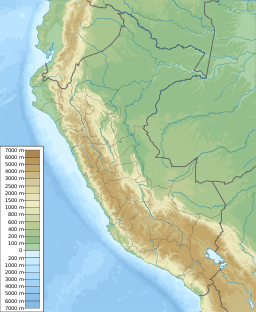| Lake Aricota | |
|---|---|
 | |
| Location | Candarave Province, Tacna Region, Peru |
| Coordinates | 17°21′36″S 70°17′37″W / 17.36000°S 70.29361°W |
| Type | Landslide lake |
| Primary inflows | Callazas River, Jaruma Creek |
| Primary outflows | Curibaya River |
| Basin countries | Peru |
| Water volume | 140 cubic kilometres (34 cu mi) |
| Surface elevation | 2,800 metres (9,186 ft) |
Lake Aricota[1][2][3] (possibly from Aymara ari pointed, sharp, quta lake)[4] is a lake in Candarave Province, region of Tacna, Peru. It has an elevation of 2,800 metres (9,186 ft) above sea level.[2][3]
Geography
The lake originated when debris flows in steep canyon walls dammed the Callazas River.[2] The waters of the lake are currently diverted to a hydroelectric plant, which has lowered the lake level from ~800.000 m3 in 1967 to a monthly average of 140.000 m3 in 2000.[2] Main inflow sources of the lake are the Callazas River and the Jaruma creek.[2] The main outflow is due to seepage through the debris dam to the Curibaya River (although hydroelectric use could count also).[2]
Waters of Lake Aricota have a high arsenic content as the waters of Callazas River and Salado River (a tributary of Jaruma Creek)[1] pass through the Yucamane volcanic area.[5]
See also
References
- ^ a b Peru 1:100 000, Tarata (35-v). IGN (Instituto Geográfico Nacional - Perú).
- ^ a b c d e f Placzek, Christa; Quade, Jay; Betancourt, Julio (2001). "Holocene Lake-Level Fluctuations of Lake Aricota, Southern Peru". Quaternary Research. 56: 181–190. doi:10.1006/qres.2001.2263.
- ^ a b "Laguna de Aricota". Inventario Turistico del Perú (in Spanish). MINCETUR. Retrieved 2016-08-17.
- ^ Radio San Gabriel, "Instituto Radiofonico de Promoción Aymara" (IRPA) 1993, Republicado por Instituto de las Lenguas y Literaturas Andinas-Amazónicas (ILLLA-A) 2011, Transcripción del Vocabulario de la Lengua Aymara, P. Ludovico Bertonio 1612 (Spanish-Aymara-Aymara-Spanish dictionary)
- ^ Murcott, Susan (2012). Arsenic Contamination in the World: An International Sourcebook 2012. IWA Publishing. p. 42. ISBN 9781780400389.

